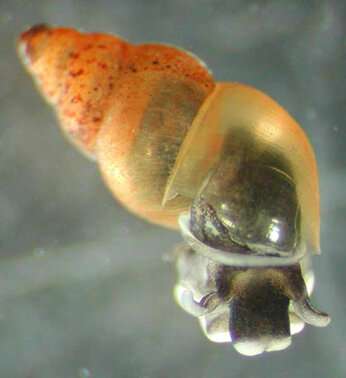This article has been reviewed according to Science X's editorial process and policies. Editors have highlighted the following attributes while ensuring the content's credibility:
fact-checked
reputable news agency
proofread
New Zealand mud snail makes its way to Lake Tahoe. And it is not welcome

In the vastness of the second-deepest lake in the United States, a tiny snail is posing a threat of "concerning" proportions. The invasive New Zealand mud snail has been discovered in Lake Tahoe.
It's unclear how this Kiwi species wound up in the cobalt blue waters of the Sierra Nevada. But, officials said Thursday, the mud snails "are able to colonize new waters quickly" and are "difficult to detect" because of their small size.
The announcement of the discovery was made by the Tahoe Regional Planning Agency and the Tahoe Resource Conservation District.
"Divers monitoring Lake Tahoe have discovered invasive New Zealand mud snails in areas off the South Shore," the agencies said in a joint release. "This is the first time the species has been detected in the Tahoe Basin."
Julie Regan, executive director of the Regional Planning Agency, called the discovery "concerning."
Invasive species can be introduced to an ecosystem through contaminated boats, fishing gear and other objects.
"It is critical that everyone remain vigilant and adhere to the mantra of Clean, Drain and Dry," Regan said in a statement. "Every boater, paddler and angler shares the responsibility to protect Lake Tahoe's native species and the waters we enjoy."
The mud snails, which resemble grains of sand, could pose a threat to the Lake Tahoe ecosystem, which is both highly protected and an important part of California and Nevada tourism. The scenic waters and surrounding areas draw tourists from all over the world in both the winter and summer seasons.
Like many aquatic invasive species "without natural predators or controls, they can out-compete native species and harm ecosystem functions," the agencies said in the release.
The first time the species was found in the United States was in Idaho in 1987. The mud snail has since been found in 22 states including California, Nevada and Colorado, as well as in the Great Lakes. It is native to freshwater bodies in New Zealand, according to the U.S. Geological Survey.
But the recent discovery marks the first time the species has been found in Lake Tahoe.
A team of experts with the Tahoe Regional Planning Agency and Conservation District is conducting further dives to determine "the extent of the infestation."
"The incident team and our partners are dedicated to protecting Lake Tahoe and will be working together to evaluate options for responding to this new finding," said Dennis Zabaglo, the aquatic invasive species program manager for the Regional Planning Agency.
©2023 Los Angeles Times.
Distributed by Tribune Content Agency, LLC.

















